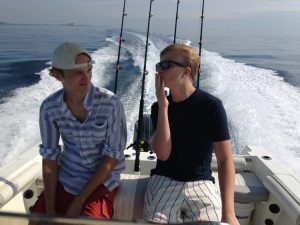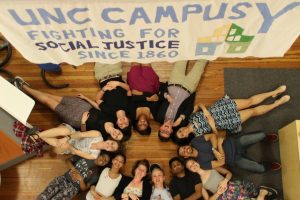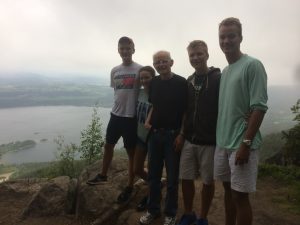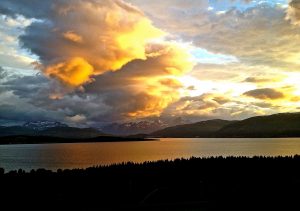Stepping up to Confront Challenges from North to South
I grew up with feet on both sides of the Atlantic—split between the Norwegian High North and the American South. And as far apart as these places are, they share more than one might think.
Photo of the Midnight Sun from Tromsø, Norway where Christian’s family is from (left). Christian on a hike on Kvaløya island, Norway (right).

The Arctic is a land apart—a timeless space untouched by the rest of the world. It is where tundra has lain frozen since time immemorial, Midnight Sun and Polar Nights warp perceptions of night and day, and spindly trees neither grow nor wither. Times change though. As in the rest of the North, climate change has come. My mother’s family’s town bustles with activity, an energy company just paved over the old farm, and instead of whalers like those my mother’s family crewed, the harbor is filled with cruise ships.
Christian and his brother fishing in South Florida.

Thousands of miles south, Florida is facing a series of parallel changes. Hurricane Irma could have wiped my family’s home (situated along a canal, in a flood zone, in a hurricane evacuation zone, and is highly susceptible to storm surge) off the map. Increasingly frequent and extreme high tides routinely inundate their street and cut their home off from the rest of the city anyways—even after the city raised linking roads and bridges.
Growing up in an international household and exposed to an issue impacting regions thousands of miles apart, I came to college wanting to learn about the global threats facing our world and began studying international relations and security. I focused my studies on the Arctic, and realizing that my Southern university could offer few Northern resources, I pursued my own study into climate change and circumpolar politics. What I learned was shocking. Arctic melting is exposing vast troves of fossil fuels, minerals, and for the first time in human history, a new ocean to navigate. Traditionally an area peripheral to global politics, the Arctic could become a potential trigger for conflict. NATO and Russia face off across a disputed Arctic Ocean containing a quarter of the world’s energy reserves.
Christian Haig and rest of the 2016 executive board of the Campus Y, UNC’s largest student organization and an umbrella for around 30 social justice and innovation initiatives.
 I was hooked and followed with additional research on polar history, energy technology, security, and Russian polar policy. I eventually worked with the State Department to study Russian energy development, and my honors thesis evaluated Western petrochemical technology transfers as a conflict prevention mechanism. With the results of my research, I eventually taught a course on contemporary Arctic issues arising from climate change. My interest in Arctic security and development issues and the use of international institutions to solidify peaceful cooperation in the region brought me to the Herbert Scoville Jr. Peace Fellowship.
I was hooked and followed with additional research on polar history, energy technology, security, and Russian polar policy. I eventually worked with the State Department to study Russian energy development, and my honors thesis evaluated Western petrochemical technology transfers as a conflict prevention mechanism. With the results of my research, I eventually taught a course on contemporary Arctic issues arising from climate change. My interest in Arctic security and development issues and the use of international institutions to solidify peaceful cooperation in the region brought me to the Herbert Scoville Jr. Peace Fellowship.
As a Scoville Fellow, I have been working at the intersection of national, energy, and environmental security at the Natural Resources Defense Council (NRDC). With NRDC, I have sought to broaden into additional areas of energy and climate security outside of the Arctic, though I have brought with me those lessons I have learned in studying the High North.
Christian, siblings, and grandfather reach the peak of
Murkgonga near Hønefoss in Southern Norway.
 Climate change is impacting every aspect of human life in every region of the world, and studying its impacts on America’s national security is highly important. As such, I have had the chance to focus on the Department of Defense’ climate and energy initiatives while at NRDC. I have learned geographic information system (GIS) tools and geospatial analysis methods to model sea level rise impacts on energy infrastructure around military installations. I have developed legislative and budget analysis skills and written on the impact of federal and state legislation targeting wind development near military bases. I have built resource guides on Department of Defense energy and climate resiliency policies and am writing about planners’ thinking on climate change for military installation development. I have begun to learn how to engage with climate skeptics on seeing climate change as a national security issue.
Climate change is impacting every aspect of human life in every region of the world, and studying its impacts on America’s national security is highly important. As such, I have had the chance to focus on the Department of Defense’ climate and energy initiatives while at NRDC. I have learned geographic information system (GIS) tools and geospatial analysis methods to model sea level rise impacts on energy infrastructure around military installations. I have developed legislative and budget analysis skills and written on the impact of federal and state legislation targeting wind development near military bases. I have built resource guides on Department of Defense energy and climate resiliency policies and am writing about planners’ thinking on climate change for military installation development. I have begun to learn how to engage with climate skeptics on seeing climate change as a national security issue.
Working on such substantive issues so quickly has accelerated my professional skills and afforded me the possibility to explore other areas of international peace and security. For instance, I helped develop a tabletop exercise for nuclear security experts to explore possible nuclear tension with Russia and China following theoretical hostilities on the Korean Peninsula. Additionally, the Fellowship has exposed me to insights from figures in the media, human rights law, think tanks, congressional research, and other areas of international peacebuilding outside of my general purview, helping me to put my own work in context.
According to the Department of Defense, climate change is a threat multiplier. Plainly stated, climate change makes every issue we’re already facing worse. It has already exacerbated or triggered conflicts in places like Mali and Syria, but the impacts of a changing environment are not sequestered to traditional geopolitical hotspots. Climate change is projectable, foreseeable, and going to impact every region of the world, and with clear eyes and firm action, we can do something about it. My generation is going to inherit a new world, and I want to do my part.
Christian Haig is a Fall 2017 Scoville Fellow at the National Resources Defense Council.

